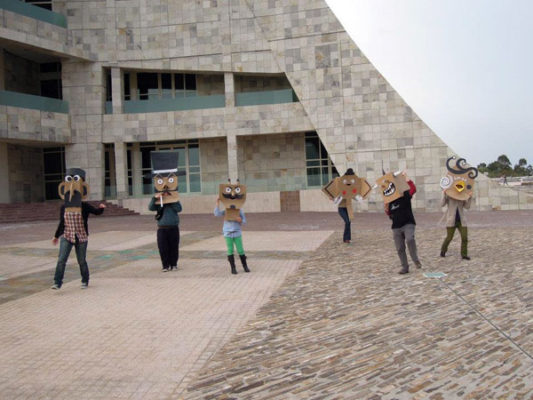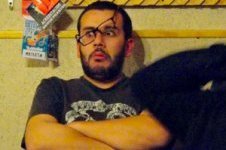Search
To search for an exact match, type the word or phrase you want in quotation marks.
A*DESK has been offering since 2002 contents about criticism and contemporary art. A*DESK has become consolidated thanks to all those who have believed in the project, all those who have followed us, debating, participating and collaborating. Many people have collaborated with A*DESK, and continue to do so. Their efforts, knowledge and belief in the project are what make it grow internationally. At A*DESK we have also generated work for over one hundred professionals in culture, from small collaborations with reviews and classes, to more prolonged and intense collaborations.
At A*DESK we believe in the need for free and universal access to culture and knowledge. We want to carry on being independent, remaining open to more ideas and opinions. If you believe in A*DESK, we need your backing to be able to continue. You can now participate in the project by supporting it. You can choose how much you want to contribute to the project.
You can decide how much you want to bring to the project.

The crisis serves as the excuse to dismantle the system of art and culture. The networks of libraries, museums and art centres suffer, if they don’t become extras or propaganda machines. Galicia, the place that reformulated an interesting network around culture, watches as it all goes down the drain. Precariousness is institutionalised and the future is ever more uncertain.
I don’t remember the moment when the captain abandoned ship, when we began to go adrift. The context for art in Galicia is a disconcerting situation. On the one hand, the failures of a project such as the Cidade da Cultura (City of Culture) have become increasingly evident, the crisis doesn´t seem to have reached its isolated terrain. To the more than three hundred million euros that the Xunta of Galicia says it has already spent on work there –currently paralysed – and the exorbitant budgets that the centre has counted on since its inauguration, bit by bit, one now has to add the cost of a million and a half euros designated to “Gallaecia Petrae”. The exhibition that will open the programme of the building destined to be a museum, in which paradoxically there isn’t one single wall upon which to hang work. Something that Peter Eisenman, after the “fucking artists” outburst of a few months ago, seems to care little about.
It already seemed to make no sense when the project “In Side” was inaugurated at the end of 2011. Eight creators, taking the work of Eisenman as their subject, developed their own interventions in the different spaces, leading to results that were nothing more than anecdotal and a pretty catalogue. Not even Miquel Navarro with his “Figuras para a batalla” (Battle figures) managed to make the proposal transcend the local.
We are at a point when the Cidade da Cultura either moves on or explodes, when the project born out of the megalomaniacal yearnings of the government of Fraga Iribarne has become a nightmare for the two following legislatures of the PSOE-BNG and now for the PP itself, for whom the joke has already cost a councillor of culture.
Some voices suggested in 2005, with the arrival of the bipartite to power, that the part already constructed of this immense complex should be demolished. However, the drastic proposal didn´t respond to a very populist strategy and the work carried on its course without knowing even then what would be the fate of each of its buildings.
Heading down the hill, the situation is quite different, the Centro Galego de Arte Contemporáneo has seen how its budget has been reduced to less than half in the last two years. Since the arrival of Miguel Von Hafe money has come in, in dribs and drabs, and the centre at times appears quite desolate. Amazingly, the programme has been maintained as much as possible, and already forgotten options such as co-production have made it possible for its spaces to continue to hold important exhibitions –Jeff Wall, Gilberto Zorio and Anna María Maiolino, amongst others- withstanding until now the budgetary disaster. However, the years when Santiago was of the leading exhibition spaces in the country, offering, thanks to budgets that enabled their elaboration, a solid programme, are now very distant. Currently, the qualitative improvement with regard to its previous director has made us see the situation with favourable eyes however the result is far from being the one desired.
MARCO, in Vigo, finds itself in an even worse situation; to the debts that the administration itself maintains with the museum, one has to add the desertions of the Diputación and Novacaixagalicia –now Novagalicia Banco – which having paid their debt have abandoned the project. In this situation, MARCO offers the following panorama: it has exhibited, since February, on the lower floor, the remains of a noteworthy programme of performances that took place over three months ago and that will be prolonged until September for no apparent reason, other than the inability to assume the cost of new productions. The exhibition of Amaya González Reyes, on the point of closing, has remained on the first floor for more than six months and the Hotel MARCO by Michael Lin in the Espazo Anexo, inaugurated in April 2011, will be maintained until October 2013. The situation therefore, despite the efforts of its team to stay afloat, is worrying to say the least. Desperate even. For example, the opening hours have been reduced to save on personnel and last summer they ended up installing an urn at the entrance to the exhibition of Martin Creed to facilitate voluntary donations, for the upkeep of the intervention.
Having reached this point, it is worth asking at what moment we went mad. On the one hand, the Cidade da Cultura taking shots in the dark with exhibition projects that in the majority of cases don’t go beyond the anecdotal. What is on offer at CGAC and MARCO is barely maintained and their days are numbered. The private entities sustaining in some cases what is on offer, however, in others, joining in the collective suicide, suddenly withdrawing even the minimum of funds to the development of the territory where they have become strong. Other spaces dependent on grants suffer and close their headquarters or string out their commitment with difficulty, while surprisingly, the galleries opt to make themselves strong in the face of adversity, offering in some cases not just an outstanding programme, but even increasing their team of international artists.
In the face of these adversities one hasn´t had to wait for a response and a series of creators and independent curators have opted to create alternative spaces in which the programme doesn’t depend on grants, the affluence of the public being not the only thing that determines their survival, their doors being open to all sorts of proposals that, on occasion, makes access possible to those who systematically have faced closed doors. Other artists, who used to have access to higher places, have opted to work for free in these collective spaces and to accept that nothing will ever be like before. This is where El Halcón Milenario (Vigo), baleiro and FAC (Santiago de Compostela) are situated, initiatives that in the last few months have become a breath of fresh air within a panorama that reeks of the moribund. We trust that these new projects bank on generating a quality programme and don’t now sink into obscurity or enter into the dynamics of a system of cultural management that has clearly worn itself out.
The case of Galicia is probably the perfect example of a complete lack of planning at all levels. Infrastructures in which multi-millionaire sums have been invested and which after their opening have been abandoned to their fate. Institutions, such as the CGAC and MARCO, that after many years of work, have seen themselves defenceless and obliged to choose at a time when all doors seem to be closed. The Galician government has moved to Gaiás and is dismantling the cultural infrastructure of a country that has taken a long time to finds its way in the panorama of a state that is still accused of extreme centralisation. In the face of this, the passivity of society that, beyond the problems that the crisis is provoking in their pockets, impassively watches the dismantling of museums, libraries, theatres and schools that have been paid with everybody’s money. A framework, that when the storm abates, will take years to return to a normality that by then will be far from normal.

Ángel Calvo Ulloa was born in a very small place full of vile characters. In the faculty where he studied nobody ever talked to him about criticism or curating, so now he dedicates his time to reading, writing and every now and again doing the odd exhibition. He loves travelling and feeling very small in a large city. He also loves going back home and once again hating this tiny place.
"A desk is a dangerous place from which to watch the world" (John Le Carré)